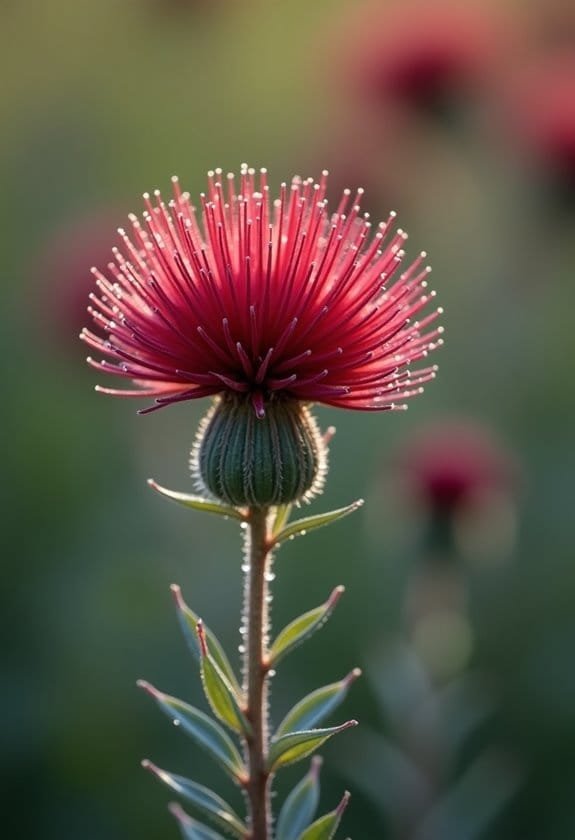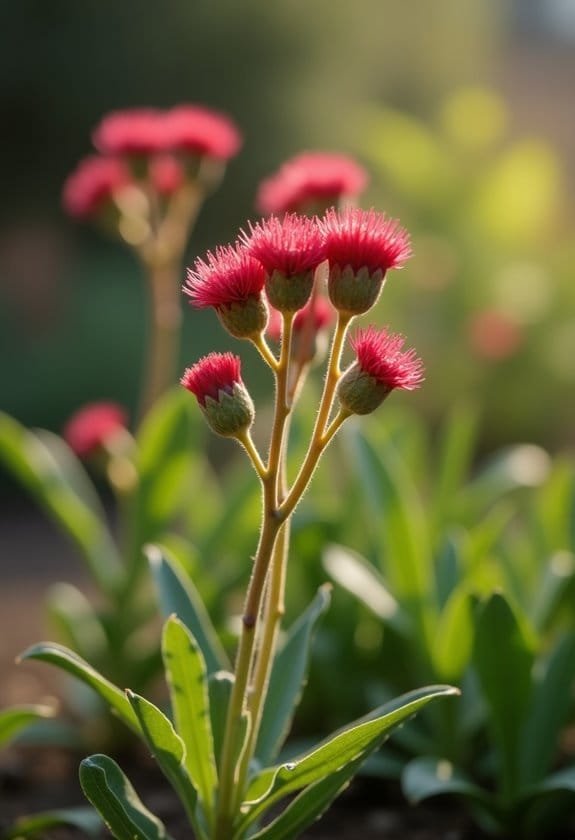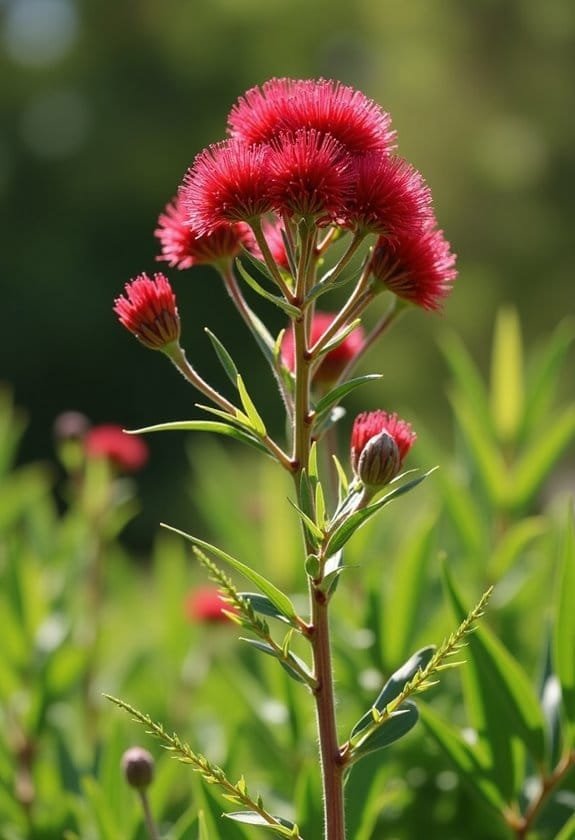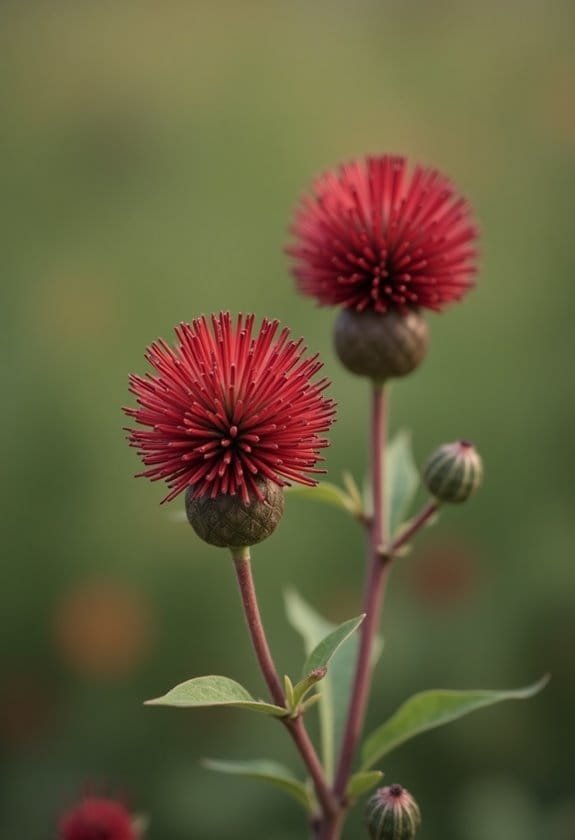Knautia macedonica, commonly known as Macedonian scabious, is a striking perennial that produces deep crimson pincushion-shaped flowers measuring 1.5 inches across. This clump-forming plant grows 18-36 inches tall and thrives in USDA zones 5-9, requiring full sun and well-drained soil. It's prized for its extended blooming period from early summer through fall, making it a valuable addition to pollinator gardens. The plant's drought tolerance and low maintenance needs complement its ability to attract bees and butterflies, while regular deadheading guarantees continuous blooms. Its robust nature and ecological benefits make it an excellent choice for gardeners seeking sustainable, long-lasting garden impact.
Main Points
- Knautia macedonica is a clump-forming perennial with deep crimson pincushion flowers that bloom from early summer through fall.
- The plant grows 18-36 inches tall, requires full sun, and thrives in well-drained soil with neutral to alkaline pH.
- Macedonian scabious attracts bees and butterflies, making it excellent for pollinator gardens and natural biodiversity enhancement.
- Regular deadheading promotes continuous blooming, while proper spacing and winter pruning maintain plant health and appearance.
- Cold-hardy in USDA zones 5-9, this plant tolerates temperatures down to -4°F and performs well in areas with cool summer nights.
Introduction

Knautia macedonica, commonly known as Macedonian scabious, stands as a distinguished member of the honeysuckle family, celebrated for its deep crimson pincushion-like blooms.
This resilient perennial, native to the diverse landscapes of central and southeastern Europe, has earned its place in gardens worldwide through its adaptable nature and striking ornamental qualities.
The plant's impressive height of 18-36 inches (45-90 cm) and spread of 18-24 inches (45-60 cm) make it an excellent choice for borders and cottage gardens, where its rich flowering display attracts a variety of beneficial pollinators throughout the growing season.
Common Name
The deep crimson blooms of Macedonian scabious grace gardens across the world as the most widely recognized common name for Knautia macedonica. This distinctive moniker reflects the plant's geographic origins in Southeastern Europe, particularly the Macedonia region, where it naturally flourishes in its native habitat.
The "scabious" portion of its common name derives from its striking resemblance to members of the Scabiosa genus, which share similar pincushion-like flower structures that have captivated gardeners for generations.
While botanically distinct from true scabious plants, Knautia macedonica's familiar nickname has persisted due to these visual parallels, making it instantly recognizable among horticultural enthusiasts.
In garden circles, Macedonian scabious has earned additional informal descriptions that reference its pollinator-friendly nature and extended blooming period.
The plant's ability to produce vibrant crimson flowers from early summer through early fall has led some gardeners to affectionately refer to it as the "summer-long bloomer" or "butterfly's pincushion," though these variations remain secondary to its primary common name.
Scientific Name
Scientifically documented by renowned botanist Grisebach, Knautia macedonica stands as this plant's accepted binomial name within the Caprifoliaceae family. This taxonomic classification represents the culmination of careful botanical study and systematic organization, placing it among other notable flowering plants in its family group.
Throughout its documented history, the species has been known by several scientific synonyms, including Scabiosa macedonica and Trichera macedonica, reflecting the evolving understanding of its botanical relationships.
The plant's current classification includes two distinct varieties: var. indivisa and var. lyrophylla, each exhibiting subtle morphological variations that botanists use to distinguish between them.
Within the broader context of its genus, Knautia macedonica shares notable characteristics with related species such as Knautia atrorubens and Scabiosa lyrophylla.
These taxonomic relationships highlight the intricate web of botanical connections that define this species' place in the scientific classification system, while also demonstrating the diversity present within the Knautia genus.
Overview
Among Europe's most enchanting ornamental plants, Macedonian scabious commands attention with its deep crimson pincushion blooms and graceful habit. This clump-forming perennial, known botanically as Knautia macedonica, emerges as a striking addition to garden landscapes, producing an abundance of richly-colored flowers from early summer through fall.
Standing proudly at heights between 18 and 36 inches, this adaptable perennial demonstrates remarkable versatility in garden settings. Its deep crimson pincushion flowers, measuring approximately 1.5 inches across, create a mesmerizing display that serves both aesthetic and ecological purposes.
The plant's natural affinity for pollinators makes it an invaluable component of wildlife-friendly gardens, attracting countless bees and butterflies throughout its extended blooming period.
What sets Knautia macedonica apart is its resilient nature and low-maintenance requirements. Thriving in full sun and well-drained soils, this central European native exhibits impressive drought tolerance and natural deer resistance.
Its self-seeding capability guarantees sustainable garden populations, while its architectural form provides both vertical interest and lasting visual impact in perennial borders and naturalized settings.
Key Features
Knautia macedonica stands as a striking perennial, growing to impressive heights of 18-36 inches with a complementary spread of 18-24 inches in ideal conditions.
The plant's most distinctive feature is its deep crimson, pincushion-like blooms, which measure approximately 1.5 inches across and create a dramatic display against its silvery-green, lobed foliage.
These eye-catching flowers grace gardens with continuous blooms from early summer through fall, making the plant a reliable source of color throughout multiple seasons.
Growth Size
Consistently thriving in garden settings, this striking perennial reaches impressive heights of 18-36 inches (45-90 cm) while spreading 18-24 inches (45-60 cm) wide. In ideal conditions, Knautia macedonica can exceed its typical growth size, pushing beyond 24 inches in height and forming substantial garden specimens.
The plant's moderate growth rate allows it to develop into dense, well-structured clumps that create an impressive display in borders and beds. Its silvery-green basal foliage, featuring distinctive lobed leaves up to 8 cm in length, provides an elegant foundation for the plant's overall architecture.
The deep crimson pincushion blooms, measuring approximately 1.5 inches (3-4 cm) in diameter, crown the upright stems and contribute considerably to the plant's vertical presence.
This well-proportioned growth pattern makes Knautia macedonica an excellent choice for middle-border positioning, where its height and spread can be fully appreciated. The plant's natural tendency to form clumps guarantees it maintains a manageable size while creating sufficient mass to make a strong visual impact in designed landscapes.
Appearance
The distinctive appearance of Knautia macedonica revolves around its deep crimson pincushion-like flower heads, which float gracefully atop slender, upright stems. These enchanting blooms measure approximately 1.5 inches across, creating striking focal points throughout the garden when in full flower.
The plant's architectural form combines a mounded base with vertical elements, reaching impressive heights between 18 and 36 inches while maintaining a proportional spread of 18 to 24 inches. Its foliage provides an elegant contrast to the vibrant flowers, featuring silvery-green, pinnately-lobed leaves that emerge from the base and can extend up to 8 centimeters in length.
The leaves' intricate patterns and subtle coloring serve as a sophisticated backdrop for the dramatic blooms.
What makes this perennial particularly striking is its overall silhouette, which presents a harmonious balance between the robust flower heads and the plant's graceful stems. The combination of deep crimson flowers, silver-tinged foliage, and its upright habit creates a compelling presence that draws both human admirers and beneficial pollinators to the garden.
Flowering Season
During the warmest months of the year, these striking crimson blooms grace gardens with their presence from early summer through early fall, creating an extended display that can last up to four months. The pincushion-like flowers, measuring 1.5 inches in diameter, stand proudly atop stems that reach impressive heights of up to 80 centimeters.
Throughout the flowering season, gardeners can maximize the plant's blooming potential through regular maintenance practices. Deadheading, the removal of spent flowers, proves particularly effective in encouraging continuous bloom production, ensuring the garden remains vibrant throughout the warm months.
These distinctive crimson blooms serve a dual purpose in the garden landscape, not only providing visual appeal but also supporting local ecosystems.
The extended flowering season makes Knautia macedonica an invaluable addition to pollinator gardens, as its nectar-rich blooms attract a diverse array of beneficial insects. Bees and butterflies frequently visit these flowers during their lengthy blooming period, establishing the plant as a reliable food source throughout the summer months and into early autumn.
Growing Requirements

Knautia macedonica demands a bright, sun-soaked location where it can bask in at least six hours of direct sunlight daily.
The plant flourishes in well-draining, moderately rich soil with neutral to alkaline pH levels, making it an adaptable choice for various garden environments.
While drought-tolerant once established, this hardy perennial performs best in zones 5-9 with medium moisture conditions and benefits from regular deadheading to sustain its impressive summer-to-fall blooming cycle.
Light
Sunlight plays an essential role in growing healthy Knautia macedonica, with these plants requiring at least 6 hours of direct sun daily for ideal flowering and growth.
These Mediterranean natives have evolved to thrive in bright, sunny conditions, which help maintain their robust structure and promote abundant blooming throughout the growing season.
While these resilient perennials can adapt to partial shade conditions, such placement may result in compromised performance and reduced flowering potential.
The plant's response to insufficient light often manifests as elongated, leggy growth patterns and diminished bloom production, indicating its strong preference for full sun exposure.
In locations with cool summer nights, proper light exposure becomes even more vital, as it helps maximize the plant's flowering capabilities and overall vigor.
Gardeners should carefully consider placement in well-drained soils where sunlight reaches the plant consistently throughout the day.
The combination of adequate light and proper drainage creates ideal growing conditions, allowing Knautia macedonica to develop its characteristic deep-colored blooms and maintain its compact, upright growth habit.
Soil
The success of growing Knautia macedonica largely depends on providing the right soil conditions. This hardy perennial shows a distinct preference for moderately fertile, well-draining soils that maintain a neutral to alkaline pH balance, making it remarkably adaptable to various garden environments.
When establishing Knautia macedonica in soils in full sun locations, gardeners should focus on creating a balanced growing medium that promotes proper drainage while retaining sufficient moisture. The plant's root system thrives in soil compositions that prevent water logging, which could otherwise lead to detrimental root rot issues.
While the plant demonstrates impressive drought tolerance once established, maintaining consistent medium moisture levels during its initial growth phase proves vital for peak development.
Regular soil assessment becomes an essential practice for maintaining vibrant Knautia macedonica specimens. Monitoring pH levels and drainage capacity guarantees the plant receives ideal growing conditions throughout its active season.
Gardeners can enhance soil quality by incorporating organic matter to improve structure, though it's important to avoid excessive fertility that might compromise the plant's natural vigor and flowering potential.
Water
Maintaining proper water balance stands essential for the successful cultivation of Knautia macedonica. This perennial species demonstrates a remarkable adaptability to moisture conditions, requiring consistent but moderate watering practices to achieve ideal growth and flowering performance.
While established plants exhibit drought tolerant characteristics, supplemental irrigation during extended dry spells helps maintain their vibrant appearance and robust blooming cycle.
The key to successful water management lies in striking a delicate balance between adequate hydration and avoiding waterlogged conditions. Regular monitoring of soil moisture levels serves as a vital practice, allowing gardeners to respond appropriately to the plant's hydration needs throughout different seasons and weather patterns.
Like many Mediterranean natives, Knautia macedonica thrives when its soil remains moderately moist but well-draining, mimicking its natural habitat conditions. Overwatering poses a significant risk to root health, potentially leading to root rot and compromised plant vigor.
During the growing season, supplemental watering should be provided when the top few inches of soil feel dry to the touch, always ensuring proper drainage to maintain ideal root zone conditions.
Temperature
Proper temperature management plays an essential role in cultivating healthy Knautia macedonica specimens. This resilient perennial demonstrates remarkable cold hardiness, thriving in USDA zones 5 through 9, where winter temperatures can plummet to −20°C (−4°F) or even lower. Its adaptability to cold climates makes it an excellent choice for gardens in temperate regions.
The plant's temperature preferences extend beyond just cold tolerance, as it shows a particular affinity for environments with cool summer nights. These lower nighttime temperatures create ideal conditions for vigorous growth and prolific blooming, making the plant especially successful in regions with moderate summer climate patterns.
While Knautia macedonica can withstand considerable heat during daylight hours, the cooling effect of evening temperatures provides a vital respite that enhances overall plant health. When selecting a planting location, gardeners should consider microclimates within their gardens that offer both the required full sun exposure and the potential for temperature moderation, particularly in areas where summer heat might otherwise prove challenging for this European native.
Pollinator Criteria
Knautia macedonica stands as a premier pollinator plant, attracting diverse beneficial insects with its rich crimson, pincushion-shaped blooms that measure 1.5 inches across.
These nectar-rich flowers serve as crucial feeding stations for bees and butterflies throughout an extended flowering period from early summer into fall.
The plant's prominent position in the Royal Horticultural Society's "Plants for Pollinators" program underscores its importance in supporting pollinator populations, while its self-seeding nature guarantees continuous habitat availability for these essential insects.
Attracted Pollinators
Consistently attracting a diverse array of pollinators, the crimson pincushion flowers of Knautia macedonica serve as crucial feeding stations for bees and butterflies throughout the summer and fall seasons.
The Royal Horticultural Society has recognized this plant's exceptional value to wildlife through their "Plants for Pollinators" program, highlighting its importance in supporting local ecosystems.
The substantial 1.5-inch flower heads function as natural gathering spots, offering abundant nectar and pollen resources that sustain various beneficial insects during critical foraging periods.
These vibrant blooms create a continuous source of sustenance, acting as reliable pit stops in the pollinator highway that connects garden spaces.
The plant's resilient nature and preference for sun-drenched, well-draining locations make it an ideal candidate for creating pollinator-friendly habitats.
As these insects move from flower to flower, they contribute notably to the garden's biodiversity and overall ecological health.
The extended blooming period guarantees that pollinators have access to essential nutrition during the most active months of their lifecycle, making Knautia macedonica an invaluable addition to any wildlife-conscious garden design.
Pollination Method
The deep crimson blooms of this Macedonian beauty rely on a specialized pollination method perfectly suited to their pincushion structure. Each flower head consists of numerous tiny florets that work together to create an efficient platform for visiting insects, particularly bees and butterflies, to land and gather nectar.
The pollination process occurs through a sophisticated interaction between the flower's structure and its insect visitors. As pollinators move across the flower head seeking nectar, they inadvertently collect pollen on their bodies, which is then transferred to other Knautia macedonica plants during subsequent visits. This cross-pollination mechanism guarantees genetic diversity within the plant population and contributes to the species' ongoing survival.
The extended flowering period from early summer through early fall maximizes the plant's reproductive success. During these vital months, the continuous presence of fresh blooms maintains a steady stream of pollinator activity, resulting in successful fertilization and seed production.
This carefully orchestrated relationship between plant and pollinator has evolved to benefit both parties, creating a sustainable ecological partnership.
Care & Maintenance

Knautia macedonica requires thoughtful placement in well-drained soil with full sun exposure to establish its robust root system and promote vigorous flowering.
Gardeners should implement regular maintenance practices, including deadheading spent blooms throughout the growing season and performing a thorough winter pruning to maintain the plant's architectural form.
This Mediterranean native pairs exceptionally well with drought-tolerant companions like Salvia and Echinacea, creating a harmonious display while sharing similar cultural requirements for ideal growth and sustainability.
Planting Tips
Successful cultivation of Knautia macedonica relies heavily on providing the right growing conditions from the start. The plant thrives in well-drained soils that maintain consistent moisture levels without becoming waterlogged, as excessive saturation can lead to root problems and compromise the basal leaves' development.
When selecting a planting location, choose a spot that receives at least six hours of direct sunlight daily, as this exposure encourages robust growth and abundant flowering. The soil should be moderately fertile and preferably neutral to alkaline in pH, though the plant demonstrates some flexibility in this regard.
Spring offers the ideal time for planting, allowing roots to establish before the summer blooming period begins. Space plants approximately 18 inches apart to accommodate their spreading habit and guarantee adequate air circulation between specimens.
When transplanting, position the crown at soil level and incorporate organic matter into the planting hole to improve drainage and nutrient availability. For best results, consider adding a layer of mulch around newly planted specimens while maintaining a small gap around the stem to prevent moisture-related issues.
Ongoing Care
Once established in ideal growing conditions, maintaining Knautia macedonica requires consistent but manageable care throughout the seasons. This hardy scabious responds well to regular deadheading, which not only keeps the plant looking tidy but also encourages continuous blooming from early summer through fall.
To guarantee peak health and vigor, gardeners should position their Knautia macedonica in full sun, where it receives at least six hours of direct sunlight daily. The plant's drought-tolerant nature means it doesn't require frequent watering once established, though well-draining soil remains essential for its success.
Regular monitoring for aphid infestations is vital, and any affected portions should be promptly removed to prevent the spread of these troublesome pests.
Late winter maintenance includes pruning back the previous year's growth, which prepares the plant for robust spring emergence.
While Knautia macedonica's self-seeding tendency can be beneficial for natural garden expansion, monitoring and managing volunteer seedlings helps maintain desired spacing and prevents overcrowding, guaranteeing each plant has adequate resources for healthy development.
Suggested Companions
When planning companion plantings for Knautia macedonica, several perennials offer both aesthetic and practical benefits. The delicate white or pink blooms of Gaura create an ethereal contrast against Knautia's deep crimson flowers, while their wispy leaves provide textural interest throughout the growing season.
Echinacea proves to be a particularly effective companion, as its sturdy cone-shaped blooms align with Knautia's flowering period, creating a pollinator-friendly habitat that buzzes with activity.
The addition of Sisyrinchium, commonly known as Blue-eyed Grass, introduces a cooling blue element that balances the intensity of Knautia's rich burgundy blooms. For a lighter touch, Coreopsis verticillata 'Moonbeam' offers airy yellow flowers that dance above its thread-like leaves, complementing Knautia's more substantial presence in the garden bed.
To maintain the structural integrity of the planting scheme, incorporating shorter perennials around Knautia's base helps prevent stem flopping while creating a layered effect that enhances the overall garden composition.
This thoughtful combination of companion plants guarantees a dynamic and visually engaging display throughout the growing season.
Common Issues
While Knautia macedonica exhibits remarkable resilience, it can face challenges from aphid infestations that require vigilant monitoring and prompt management through natural predators or organic controls.
Poor drainage in heavy soils presents a significant threat to the plant's root system, potentially leading to root rot and compromised plant health, especially during periods of excessive rainfall.
The plant's tendency to become leggy in overly rich soils or crowded conditions can be addressed by selecting compact cultivars and maintaining appropriate spacing between specimens.
Pests/Diseases
Fortunately for gardeners, Knautia macedonica stands out as a remarkably disease-resistant plant that faces few pest challenges. This resilient herbaceous perennial typically maintains robust health throughout its growing season, requiring minimal intervention for pest management.
The primary concern that gardeners should monitor is the potential presence of aphids, which can occasionally colonize both the foliage and flowering portions of the plant. These small sap-sucking insects, while troublesome, can be effectively managed through regular inspection and prompt removal of affected plant sections.
Maintaining ideal growing conditions, particularly well-drained soil and adequate sunlight exposure, serves as a natural deterrent against pest infestations.
To further protect the plant's health, implementing regular maintenance practices proves beneficial. Deadheading spent blooms not only encourages continued flowering but also eliminates potential pest habitats.
While Knautia macedonica may self-seed prolifically under favorable conditions, proper spacing and timely removal of overcrowded seedlings help maintain vigorous growth and reduce competition, ultimately contributing to the plant's natural resistance against both pests and diseases.
Solutions
Despite its robust nature, Knautia macedonica can face several common issues that gardeners should address promptly. The plant's tendency to flop, particularly in taller varieties, can be effectively managed by installing stakes or selecting more compact cultivars that maintain their structure naturally.
For peak growth, positioning the plant in well-drained soils in full sunlight creates an environment where it can thrive without developing stress-related problems. When overcrowding occurs due to self-seeding, implementing a strategic thinning program helps maintain appropriate spacing between plants, ensuring each specimen receives adequate nutrients and airflow.
The maintenance of continuous blooming requires regular deadheading, which not only promotes fresh flower production but also prevents the plant from becoming unkempt.
When aphid infestations appear, swift intervention through the removal of affected foliage or the application of appropriate insecticidal solutions prevents these pests from establishing larger colonies.
Maintaining proper cultural conditions, including moderately fertile soil and consistent moisture levels without waterlogging, serves as a preventive measure against most potential issues that might affect this otherwise hardy perennial.
Summary

Knautia macedonica stands out as a versatile perennial garden plant, producing deep crimson pincushion flowers that bloom from early summer through fall. Also known as Macedonian scabious, this robust perennial forms impressive clumps reaching heights of 18-36 inches and spreading 18-24 inches wide, creating a striking presence in garden landscapes.
The plant's adaptability to various growing conditions makes it an excellent choice for gardens in hardiness zones 5 through 9, where it thrives in full sun and well-drained soils. Its drought tolerance, once established, adds to its appeal as a low-maintenance option for both formal gardens and naturalized settings.
Regular deadheading encourages continuous blooming, while its self-seeding capability guarantees sustained garden displays over time.
Beyond its ornamental value, Knautia macedonica serves an essential ecological role by attracting diverse pollinators, including bees and butterflies, to the garden. This central European native has proven itself as a reliable performer that combines aesthetic appeal with environmental benefits, making it an invaluable addition to any pollinator-friendly garden design.


